Essay on Managing HRM Challenges in the Hospitality Sector - HRM20024
VerifiedAdded on 2023/06/04
|11
|3657
|305
Essay
AI Summary
This essay delves into the critical aspects of human resource management (HRM) within the dynamic hospitality industry. It explores key challenges such as recruitment and selection, employee retention, performance management, human resource development, managing diversity, and work-life balance. The essay highlights the importance of strategic HRM in the hospitality sector, emphasizing the role of employees in delivering quality service and achieving organizational goals. It examines the impact of recruitment strategies, the significance of performance management systems, and the need for employee development and career planning. Furthermore, it addresses the complexities of managing diversity and promoting work-life balance to foster a positive and productive work environment. The analysis draws upon various sources, including journal articles, reports, and articles written by economists, to provide a comprehensive overview of the current HRM landscape and identify potential solutions to the challenges faced by hospitality organizations.
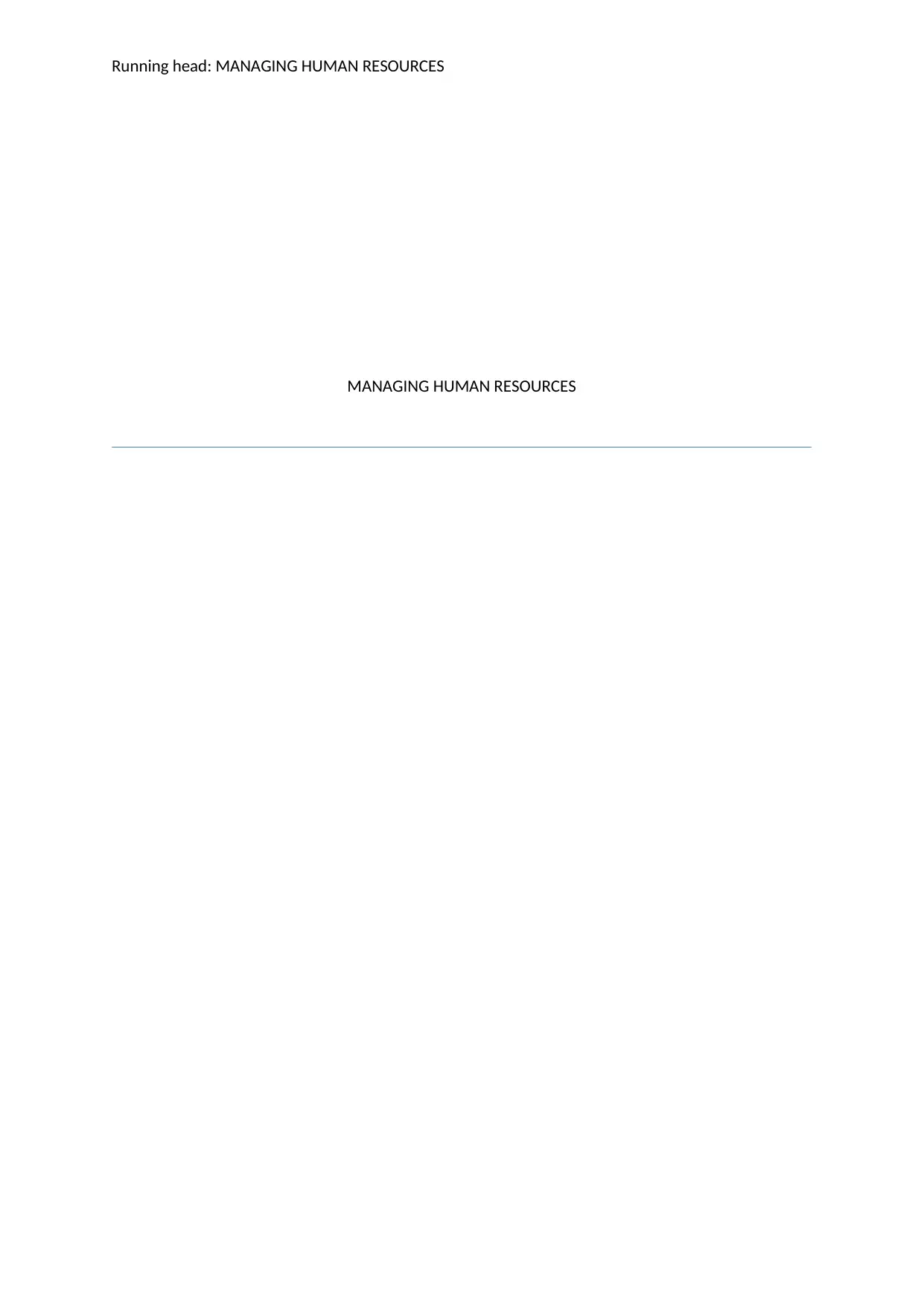
Running head: MANAGING HUMAN RESOURCES
MANAGING HUMAN RESOURCES
MANAGING HUMAN RESOURCES
Paraphrase This Document
Need a fresh take? Get an instant paraphrase of this document with our AI Paraphraser
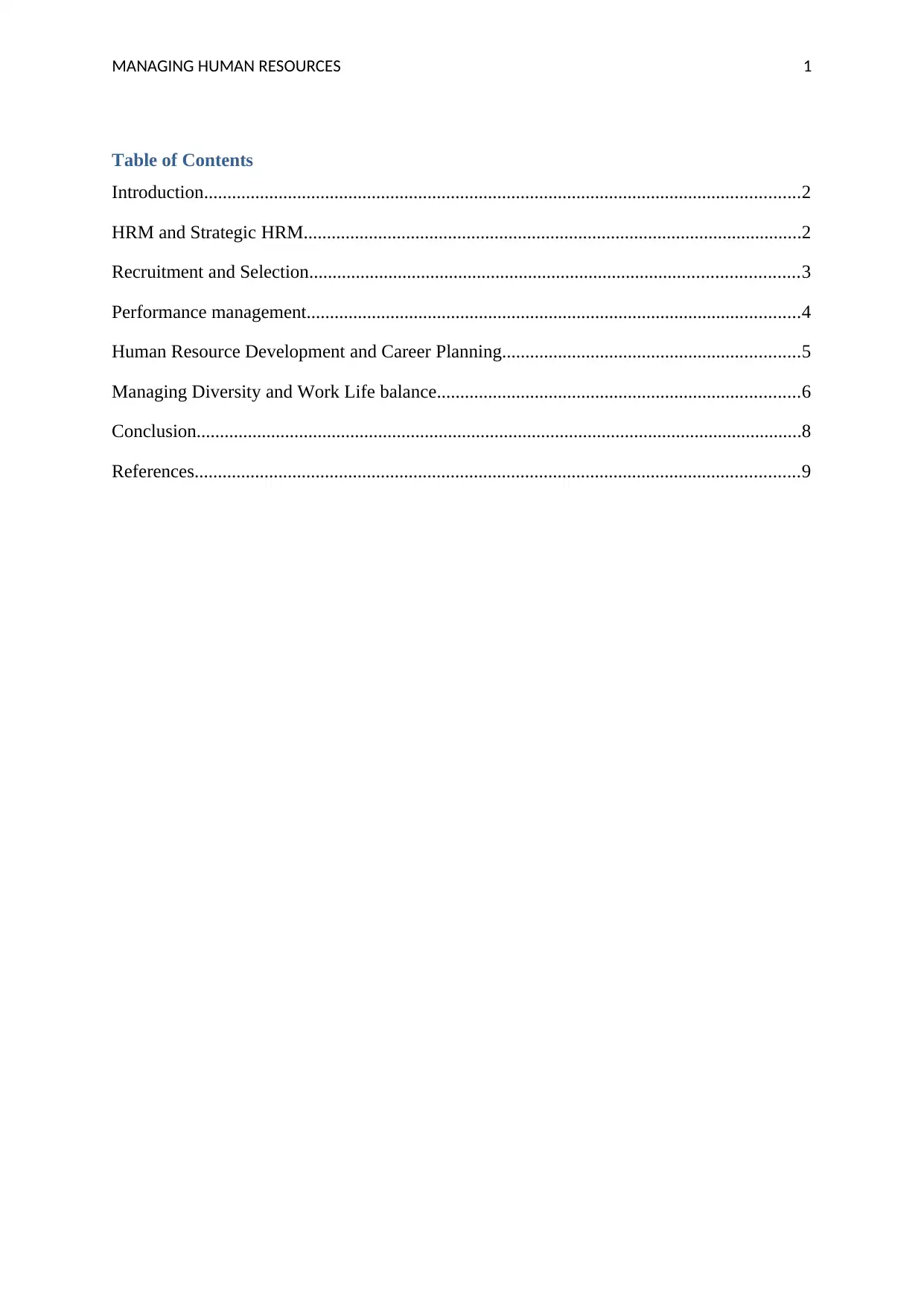
MANAGING HUMAN RESOURCES 1
Table of Contents
Introduction................................................................................................................................2
HRM and Strategic HRM...........................................................................................................2
Recruitment and Selection.........................................................................................................3
Performance management..........................................................................................................4
Human Resource Development and Career Planning................................................................5
Managing Diversity and Work Life balance..............................................................................6
Conclusion..................................................................................................................................8
References..................................................................................................................................9
Table of Contents
Introduction................................................................................................................................2
HRM and Strategic HRM...........................................................................................................2
Recruitment and Selection.........................................................................................................3
Performance management..........................................................................................................4
Human Resource Development and Career Planning................................................................5
Managing Diversity and Work Life balance..............................................................................6
Conclusion..................................................................................................................................8
References..................................................................................................................................9
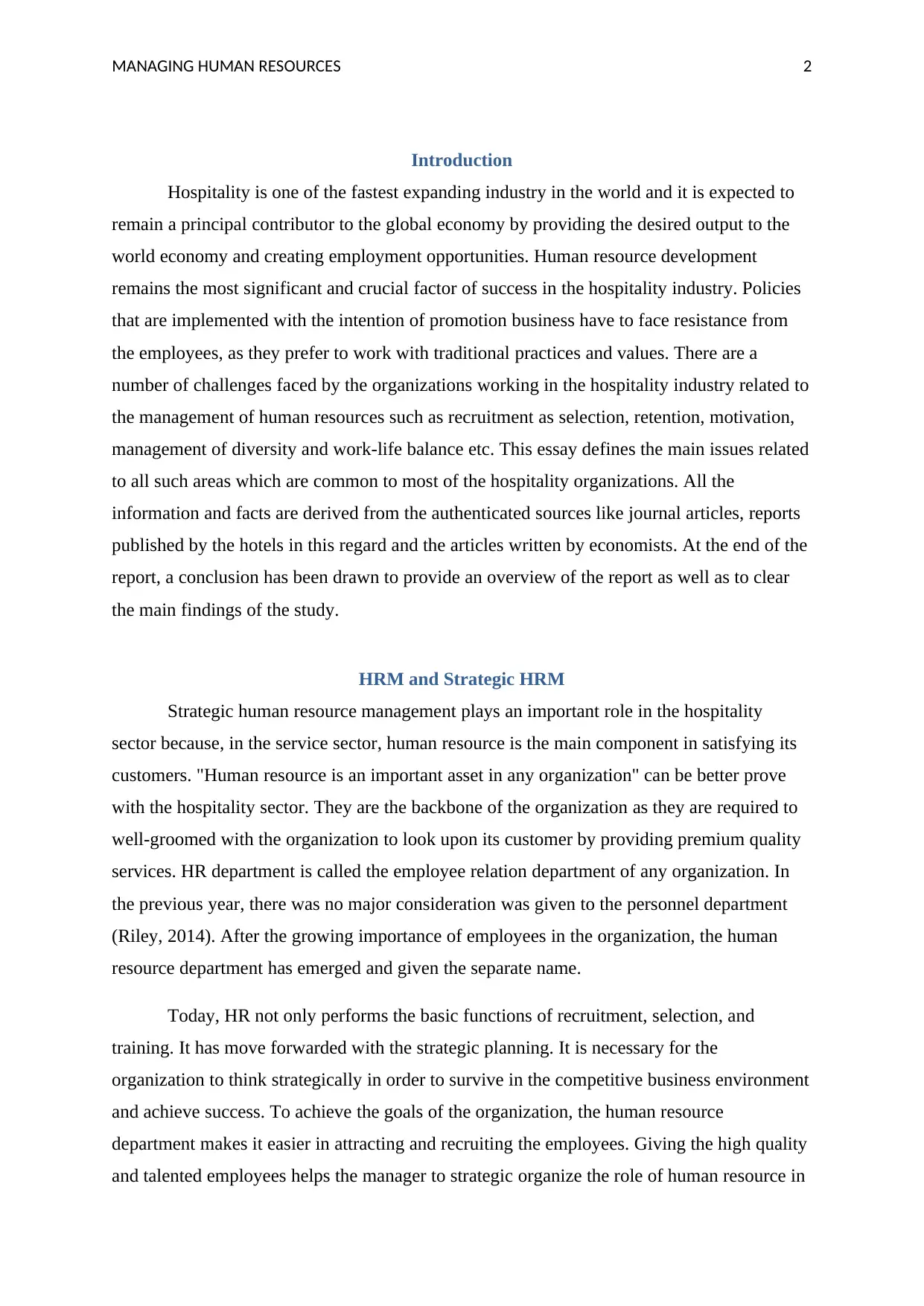
MANAGING HUMAN RESOURCES 2
Introduction
Hospitality is one of the fastest expanding industry in the world and it is expected to
remain a principal contributor to the global economy by providing the desired output to the
world economy and creating employment opportunities. Human resource development
remains the most significant and crucial factor of success in the hospitality industry. Policies
that are implemented with the intention of promotion business have to face resistance from
the employees, as they prefer to work with traditional practices and values. There are a
number of challenges faced by the organizations working in the hospitality industry related to
the management of human resources such as recruitment as selection, retention, motivation,
management of diversity and work-life balance etc. This essay defines the main issues related
to all such areas which are common to most of the hospitality organizations. All the
information and facts are derived from the authenticated sources like journal articles, reports
published by the hotels in this regard and the articles written by economists. At the end of the
report, a conclusion has been drawn to provide an overview of the report as well as to clear
the main findings of the study.
HRM and Strategic HRM
Strategic human resource management plays an important role in the hospitality
sector because, in the service sector, human resource is the main component in satisfying its
customers. "Human resource is an important asset in any organization" can be better prove
with the hospitality sector. They are the backbone of the organization as they are required to
well-groomed with the organization to look upon its customer by providing premium quality
services. HR department is called the employee relation department of any organization. In
the previous year, there was no major consideration was given to the personnel department
(Riley, 2014). After the growing importance of employees in the organization, the human
resource department has emerged and given the separate name.
Today, HR not only performs the basic functions of recruitment, selection, and
training. It has move forwarded with the strategic planning. It is necessary for the
organization to think strategically in order to survive in the competitive business environment
and achieve success. To achieve the goals of the organization, the human resource
department makes it easier in attracting and recruiting the employees. Giving the high quality
and talented employees helps the manager to strategic organize the role of human resource in
Introduction
Hospitality is one of the fastest expanding industry in the world and it is expected to
remain a principal contributor to the global economy by providing the desired output to the
world economy and creating employment opportunities. Human resource development
remains the most significant and crucial factor of success in the hospitality industry. Policies
that are implemented with the intention of promotion business have to face resistance from
the employees, as they prefer to work with traditional practices and values. There are a
number of challenges faced by the organizations working in the hospitality industry related to
the management of human resources such as recruitment as selection, retention, motivation,
management of diversity and work-life balance etc. This essay defines the main issues related
to all such areas which are common to most of the hospitality organizations. All the
information and facts are derived from the authenticated sources like journal articles, reports
published by the hotels in this regard and the articles written by economists. At the end of the
report, a conclusion has been drawn to provide an overview of the report as well as to clear
the main findings of the study.
HRM and Strategic HRM
Strategic human resource management plays an important role in the hospitality
sector because, in the service sector, human resource is the main component in satisfying its
customers. "Human resource is an important asset in any organization" can be better prove
with the hospitality sector. They are the backbone of the organization as they are required to
well-groomed with the organization to look upon its customer by providing premium quality
services. HR department is called the employee relation department of any organization. In
the previous year, there was no major consideration was given to the personnel department
(Riley, 2014). After the growing importance of employees in the organization, the human
resource department has emerged and given the separate name.
Today, HR not only performs the basic functions of recruitment, selection, and
training. It has move forwarded with the strategic planning. It is necessary for the
organization to think strategically in order to survive in the competitive business environment
and achieve success. To achieve the goals of the organization, the human resource
department makes it easier in attracting and recruiting the employees. Giving the high quality
and talented employees helps the manager to strategic organize the role of human resource in
⊘ This is a preview!⊘
Do you want full access?
Subscribe today to unlock all pages.

Trusted by 1+ million students worldwide
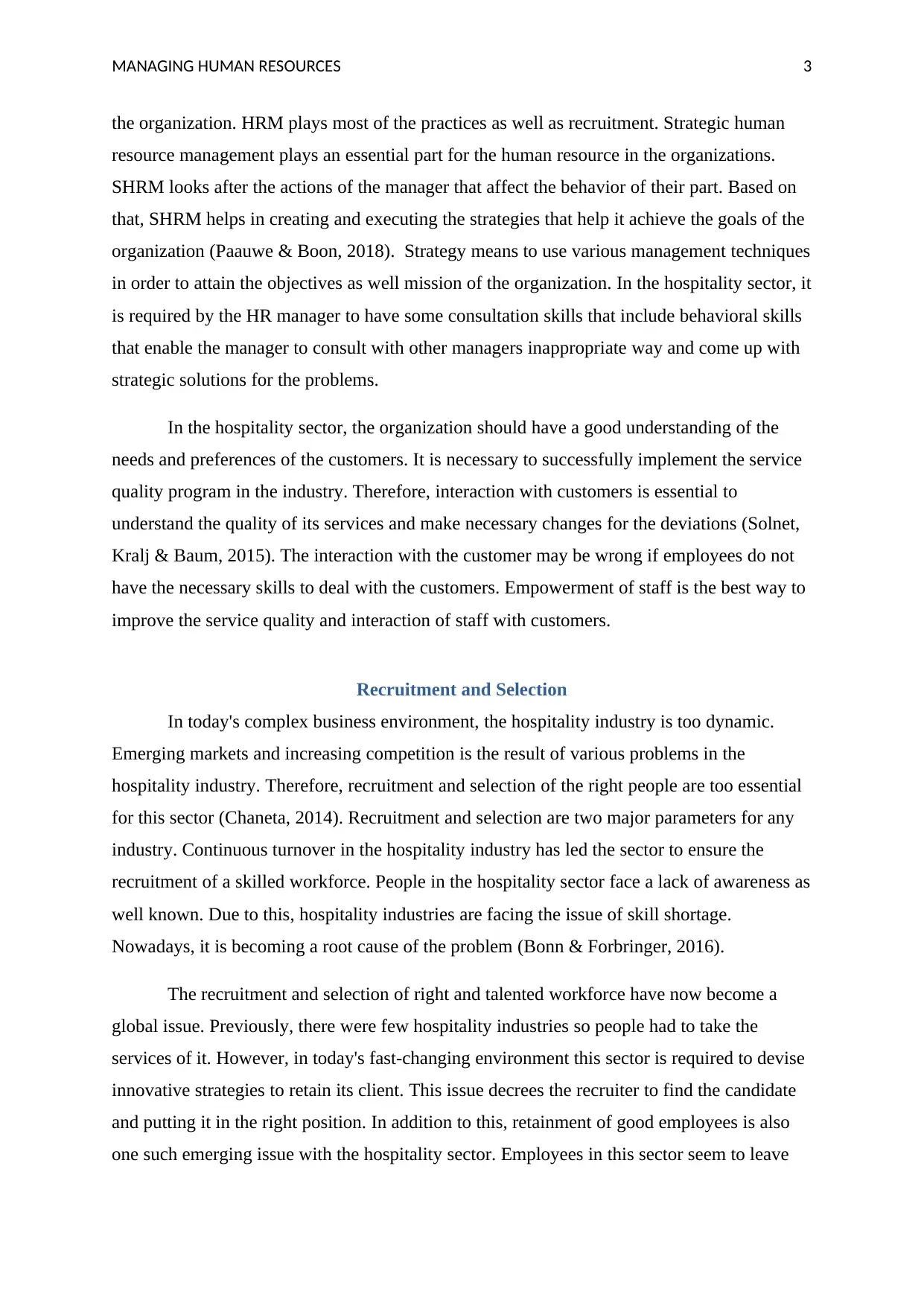
MANAGING HUMAN RESOURCES 3
the organization. HRM plays most of the practices as well as recruitment. Strategic human
resource management plays an essential part for the human resource in the organizations.
SHRM looks after the actions of the manager that affect the behavior of their part. Based on
that, SHRM helps in creating and executing the strategies that help it achieve the goals of the
organization (Paauwe & Boon, 2018). Strategy means to use various management techniques
in order to attain the objectives as well mission of the organization. In the hospitality sector, it
is required by the HR manager to have some consultation skills that include behavioral skills
that enable the manager to consult with other managers inappropriate way and come up with
strategic solutions for the problems.
In the hospitality sector, the organization should have a good understanding of the
needs and preferences of the customers. It is necessary to successfully implement the service
quality program in the industry. Therefore, interaction with customers is essential to
understand the quality of its services and make necessary changes for the deviations (Solnet,
Kralj & Baum, 2015). The interaction with the customer may be wrong if employees do not
have the necessary skills to deal with the customers. Empowerment of staff is the best way to
improve the service quality and interaction of staff with customers.
Recruitment and Selection
In today's complex business environment, the hospitality industry is too dynamic.
Emerging markets and increasing competition is the result of various problems in the
hospitality industry. Therefore, recruitment and selection of the right people are too essential
for this sector (Chaneta, 2014). Recruitment and selection are two major parameters for any
industry. Continuous turnover in the hospitality industry has led the sector to ensure the
recruitment of a skilled workforce. People in the hospitality sector face a lack of awareness as
well known. Due to this, hospitality industries are facing the issue of skill shortage.
Nowadays, it is becoming a root cause of the problem (Bonn & Forbringer, 2016).
The recruitment and selection of right and talented workforce have now become a
global issue. Previously, there were few hospitality industries so people had to take the
services of it. However, in today's fast-changing environment this sector is required to devise
innovative strategies to retain its client. This issue decrees the recruiter to find the candidate
and putting it in the right position. In addition to this, retainment of good employees is also
one such emerging issue with the hospitality sector. Employees in this sector seem to leave
the organization. HRM plays most of the practices as well as recruitment. Strategic human
resource management plays an essential part for the human resource in the organizations.
SHRM looks after the actions of the manager that affect the behavior of their part. Based on
that, SHRM helps in creating and executing the strategies that help it achieve the goals of the
organization (Paauwe & Boon, 2018). Strategy means to use various management techniques
in order to attain the objectives as well mission of the organization. In the hospitality sector, it
is required by the HR manager to have some consultation skills that include behavioral skills
that enable the manager to consult with other managers inappropriate way and come up with
strategic solutions for the problems.
In the hospitality sector, the organization should have a good understanding of the
needs and preferences of the customers. It is necessary to successfully implement the service
quality program in the industry. Therefore, interaction with customers is essential to
understand the quality of its services and make necessary changes for the deviations (Solnet,
Kralj & Baum, 2015). The interaction with the customer may be wrong if employees do not
have the necessary skills to deal with the customers. Empowerment of staff is the best way to
improve the service quality and interaction of staff with customers.
Recruitment and Selection
In today's complex business environment, the hospitality industry is too dynamic.
Emerging markets and increasing competition is the result of various problems in the
hospitality industry. Therefore, recruitment and selection of the right people are too essential
for this sector (Chaneta, 2014). Recruitment and selection are two major parameters for any
industry. Continuous turnover in the hospitality industry has led the sector to ensure the
recruitment of a skilled workforce. People in the hospitality sector face a lack of awareness as
well known. Due to this, hospitality industries are facing the issue of skill shortage.
Nowadays, it is becoming a root cause of the problem (Bonn & Forbringer, 2016).
The recruitment and selection of right and talented workforce have now become a
global issue. Previously, there were few hospitality industries so people had to take the
services of it. However, in today's fast-changing environment this sector is required to devise
innovative strategies to retain its client. This issue decrees the recruiter to find the candidate
and putting it in the right position. In addition to this, retainment of good employees is also
one such emerging issue with the hospitality sector. Employees in this sector seem to leave
Paraphrase This Document
Need a fresh take? Get an instant paraphrase of this document with our AI Paraphraser

MANAGING HUMAN RESOURCES 4
early when they find any new opportunity or due to some other reasons. Therefore, selection
of employee with satisfies time durable is a big question for the recruiter. In this sector, the
major issue is recruiting and selecting the candidate for leadership and management role so
that it can continuously lead the team members as well as operations (Chan & Kuok, 2011).
There are various methods used in the selection of the workforce in the hospitality
sector. The selection process begins by inviting the candidates for the job. Hospitality sector
looks for various professional techniques as well as the communication skills of the
candidate. Like the employee in the hospitality sector is meant for the customer friendly
person. After the selection of the person through the strong background, several steps need to
be followed. A personal interview is mandatory to take because it reveals the strength of the
employee in a better way. While taking the interview, various things are being checked such
as its previous experience, interest for the job, keen to talk with customers as well as body
language. All these things are considered while recruiting and selecting a person for the
hospitality industry.
Performance management
Performance management involves those activities which ensure the goals are met in
an efficient and effective manner. It focuses on the performance of a department, employee,
organization, as well as the process to build service or product. Various determinants affect
individual performance in an organization. Among all, motivation is the first force that drives
a person to perform better. Performance of individual is also affected by the individual
competence to perform a specific job. In the hospitality sector, a person's competence plays a
major role in the performance of the employee (Marshall, Mottier & Lewis, 2015). The
environment of the workplace is also an important determinant in individual performance.
Therefore, the organization should be designed in such a way that enables the employees to
put their skills and expertise on work. There are various purposes of performance
management. As industries invest so much of their time, they require to get the positive
results in return (Mone & London, 2018). Besides this, performance management is done to
help the employees understand what they are doing and what they should do to improve their
performance. Another reason is that performance management is a great tool to prevent the
problems that are coming on the way. It allows the organization to know the progress toward
the accomplishment of performance standards and desired goals (Ishizaka & Pereira, 2016).
early when they find any new opportunity or due to some other reasons. Therefore, selection
of employee with satisfies time durable is a big question for the recruiter. In this sector, the
major issue is recruiting and selecting the candidate for leadership and management role so
that it can continuously lead the team members as well as operations (Chan & Kuok, 2011).
There are various methods used in the selection of the workforce in the hospitality
sector. The selection process begins by inviting the candidates for the job. Hospitality sector
looks for various professional techniques as well as the communication skills of the
candidate. Like the employee in the hospitality sector is meant for the customer friendly
person. After the selection of the person through the strong background, several steps need to
be followed. A personal interview is mandatory to take because it reveals the strength of the
employee in a better way. While taking the interview, various things are being checked such
as its previous experience, interest for the job, keen to talk with customers as well as body
language. All these things are considered while recruiting and selecting a person for the
hospitality industry.
Performance management
Performance management involves those activities which ensure the goals are met in
an efficient and effective manner. It focuses on the performance of a department, employee,
organization, as well as the process to build service or product. Various determinants affect
individual performance in an organization. Among all, motivation is the first force that drives
a person to perform better. Performance of individual is also affected by the individual
competence to perform a specific job. In the hospitality sector, a person's competence plays a
major role in the performance of the employee (Marshall, Mottier & Lewis, 2015). The
environment of the workplace is also an important determinant in individual performance.
Therefore, the organization should be designed in such a way that enables the employees to
put their skills and expertise on work. There are various purposes of performance
management. As industries invest so much of their time, they require to get the positive
results in return (Mone & London, 2018). Besides this, performance management is done to
help the employees understand what they are doing and what they should do to improve their
performance. Another reason is that performance management is a great tool to prevent the
problems that are coming on the way. It allows the organization to know the progress toward
the accomplishment of performance standards and desired goals (Ishizaka & Pereira, 2016).
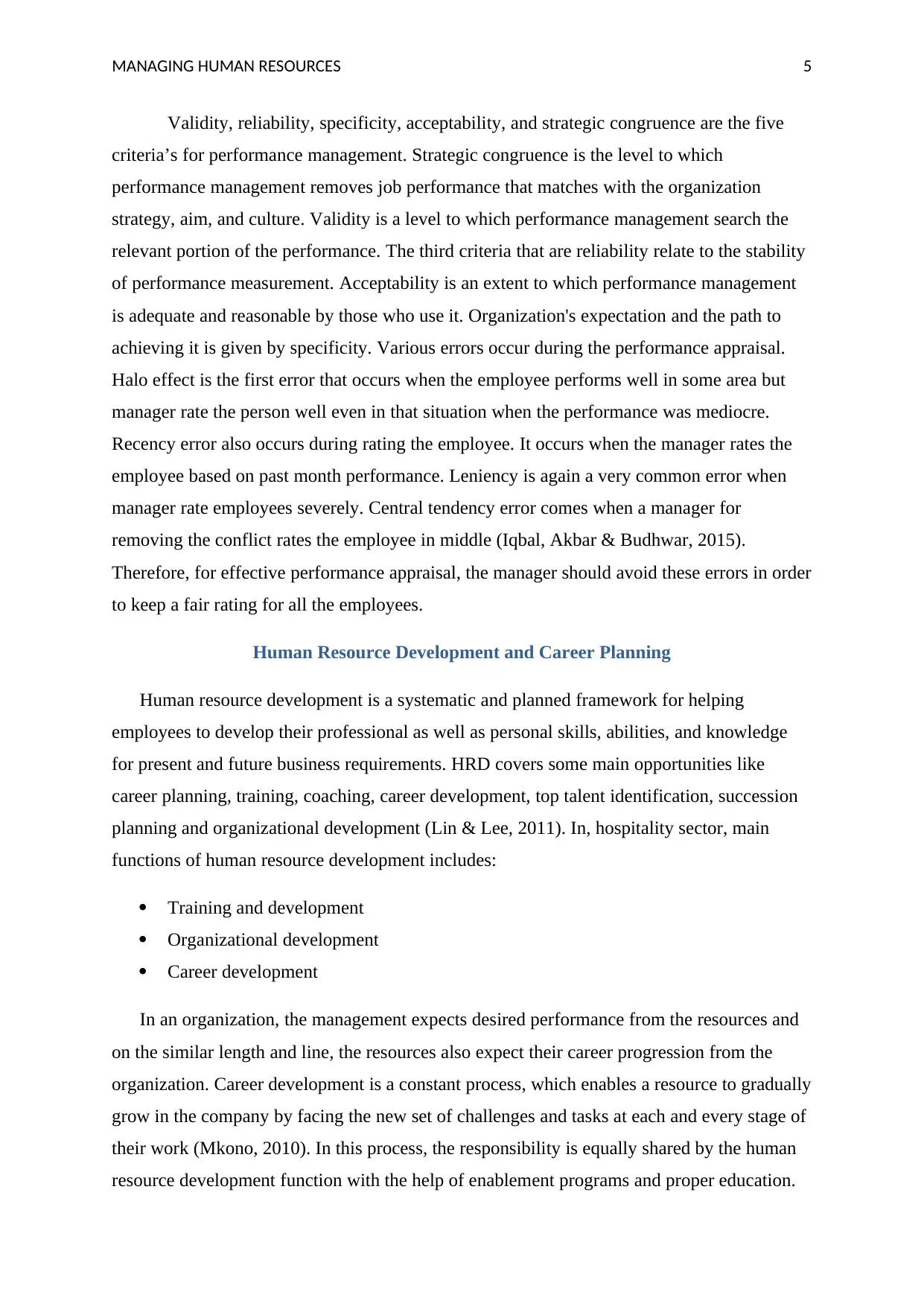
MANAGING HUMAN RESOURCES 5
Validity, reliability, specificity, acceptability, and strategic congruence are the five
criteria’s for performance management. Strategic congruence is the level to which
performance management removes job performance that matches with the organization
strategy, aim, and culture. Validity is a level to which performance management search the
relevant portion of the performance. The third criteria that are reliability relate to the stability
of performance measurement. Acceptability is an extent to which performance management
is adequate and reasonable by those who use it. Organization's expectation and the path to
achieving it is given by specificity. Various errors occur during the performance appraisal.
Halo effect is the first error that occurs when the employee performs well in some area but
manager rate the person well even in that situation when the performance was mediocre.
Recency error also occurs during rating the employee. It occurs when the manager rates the
employee based on past month performance. Leniency is again a very common error when
manager rate employees severely. Central tendency error comes when a manager for
removing the conflict rates the employee in middle (Iqbal, Akbar & Budhwar, 2015).
Therefore, for effective performance appraisal, the manager should avoid these errors in order
to keep a fair rating for all the employees.
Human Resource Development and Career Planning
Human resource development is a systematic and planned framework for helping
employees to develop their professional as well as personal skills, abilities, and knowledge
for present and future business requirements. HRD covers some main opportunities like
career planning, training, coaching, career development, top talent identification, succession
planning and organizational development (Lin & Lee, 2011). In, hospitality sector, main
functions of human resource development includes:
Training and development
Organizational development
Career development
In an organization, the management expects desired performance from the resources and
on the similar length and line, the resources also expect their career progression from the
organization. Career development is a constant process, which enables a resource to gradually
grow in the company by facing the new set of challenges and tasks at each and every stage of
their work (Mkono, 2010). In this process, the responsibility is equally shared by the human
resource development function with the help of enablement programs and proper education.
Validity, reliability, specificity, acceptability, and strategic congruence are the five
criteria’s for performance management. Strategic congruence is the level to which
performance management removes job performance that matches with the organization
strategy, aim, and culture. Validity is a level to which performance management search the
relevant portion of the performance. The third criteria that are reliability relate to the stability
of performance measurement. Acceptability is an extent to which performance management
is adequate and reasonable by those who use it. Organization's expectation and the path to
achieving it is given by specificity. Various errors occur during the performance appraisal.
Halo effect is the first error that occurs when the employee performs well in some area but
manager rate the person well even in that situation when the performance was mediocre.
Recency error also occurs during rating the employee. It occurs when the manager rates the
employee based on past month performance. Leniency is again a very common error when
manager rate employees severely. Central tendency error comes when a manager for
removing the conflict rates the employee in middle (Iqbal, Akbar & Budhwar, 2015).
Therefore, for effective performance appraisal, the manager should avoid these errors in order
to keep a fair rating for all the employees.
Human Resource Development and Career Planning
Human resource development is a systematic and planned framework for helping
employees to develop their professional as well as personal skills, abilities, and knowledge
for present and future business requirements. HRD covers some main opportunities like
career planning, training, coaching, career development, top talent identification, succession
planning and organizational development (Lin & Lee, 2011). In, hospitality sector, main
functions of human resource development includes:
Training and development
Organizational development
Career development
In an organization, the management expects desired performance from the resources and
on the similar length and line, the resources also expect their career progression from the
organization. Career development is a constant process, which enables a resource to gradually
grow in the company by facing the new set of challenges and tasks at each and every stage of
their work (Mkono, 2010). In this process, the responsibility is equally shared by the human
resource development function with the help of enablement programs and proper education.
⊘ This is a preview!⊘
Do you want full access?
Subscribe today to unlock all pages.

Trusted by 1+ million students worldwide
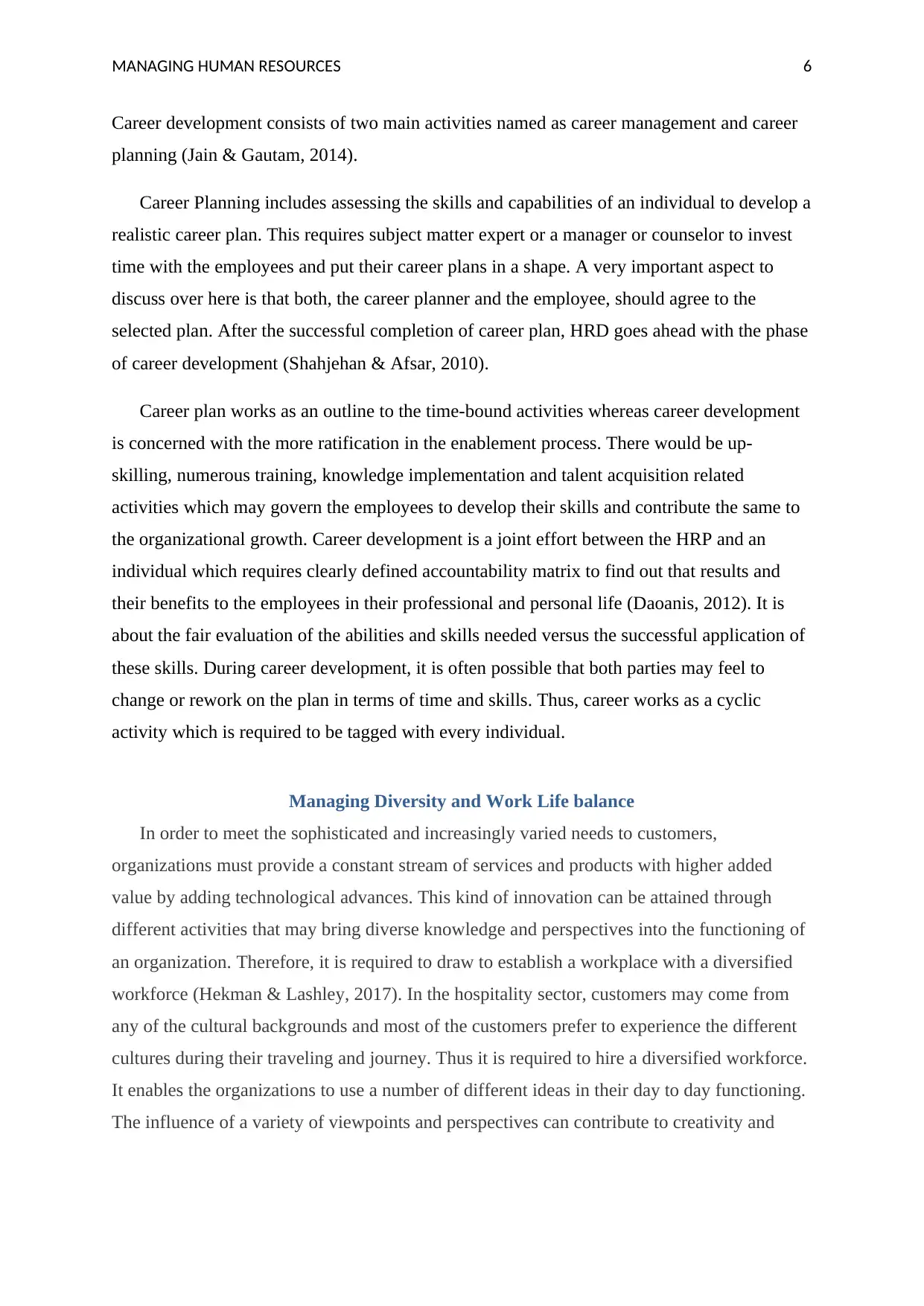
MANAGING HUMAN RESOURCES 6
Career development consists of two main activities named as career management and career
planning (Jain & Gautam, 2014).
Career Planning includes assessing the skills and capabilities of an individual to develop a
realistic career plan. This requires subject matter expert or a manager or counselor to invest
time with the employees and put their career plans in a shape. A very important aspect to
discuss over here is that both, the career planner and the employee, should agree to the
selected plan. After the successful completion of career plan, HRD goes ahead with the phase
of career development (Shahjehan & Afsar, 2010).
Career plan works as an outline to the time-bound activities whereas career development
is concerned with the more ratification in the enablement process. There would be up-
skilling, numerous training, knowledge implementation and talent acquisition related
activities which may govern the employees to develop their skills and contribute the same to
the organizational growth. Career development is a joint effort between the HRP and an
individual which requires clearly defined accountability matrix to find out that results and
their benefits to the employees in their professional and personal life (Daoanis, 2012). It is
about the fair evaluation of the abilities and skills needed versus the successful application of
these skills. During career development, it is often possible that both parties may feel to
change or rework on the plan in terms of time and skills. Thus, career works as a cyclic
activity which is required to be tagged with every individual.
Managing Diversity and Work Life balance
In order to meet the sophisticated and increasingly varied needs to customers,
organizations must provide a constant stream of services and products with higher added
value by adding technological advances. This kind of innovation can be attained through
different activities that may bring diverse knowledge and perspectives into the functioning of
an organization. Therefore, it is required to draw to establish a workplace with a diversified
workforce (Hekman & Lashley, 2017). In the hospitality sector, customers may come from
any of the cultural backgrounds and most of the customers prefer to experience the different
cultures during their traveling and journey. Thus it is required to hire a diversified workforce.
It enables the organizations to use a number of different ideas in their day to day functioning.
The influence of a variety of viewpoints and perspectives can contribute to creativity and
Career development consists of two main activities named as career management and career
planning (Jain & Gautam, 2014).
Career Planning includes assessing the skills and capabilities of an individual to develop a
realistic career plan. This requires subject matter expert or a manager or counselor to invest
time with the employees and put their career plans in a shape. A very important aspect to
discuss over here is that both, the career planner and the employee, should agree to the
selected plan. After the successful completion of career plan, HRD goes ahead with the phase
of career development (Shahjehan & Afsar, 2010).
Career plan works as an outline to the time-bound activities whereas career development
is concerned with the more ratification in the enablement process. There would be up-
skilling, numerous training, knowledge implementation and talent acquisition related
activities which may govern the employees to develop their skills and contribute the same to
the organizational growth. Career development is a joint effort between the HRP and an
individual which requires clearly defined accountability matrix to find out that results and
their benefits to the employees in their professional and personal life (Daoanis, 2012). It is
about the fair evaluation of the abilities and skills needed versus the successful application of
these skills. During career development, it is often possible that both parties may feel to
change or rework on the plan in terms of time and skills. Thus, career works as a cyclic
activity which is required to be tagged with every individual.
Managing Diversity and Work Life balance
In order to meet the sophisticated and increasingly varied needs to customers,
organizations must provide a constant stream of services and products with higher added
value by adding technological advances. This kind of innovation can be attained through
different activities that may bring diverse knowledge and perspectives into the functioning of
an organization. Therefore, it is required to draw to establish a workplace with a diversified
workforce (Hekman & Lashley, 2017). In the hospitality sector, customers may come from
any of the cultural backgrounds and most of the customers prefer to experience the different
cultures during their traveling and journey. Thus it is required to hire a diversified workforce.
It enables the organizations to use a number of different ideas in their day to day functioning.
The influence of a variety of viewpoints and perspectives can contribute to creativity and
Paraphrase This Document
Need a fresh take? Get an instant paraphrase of this document with our AI Paraphraser
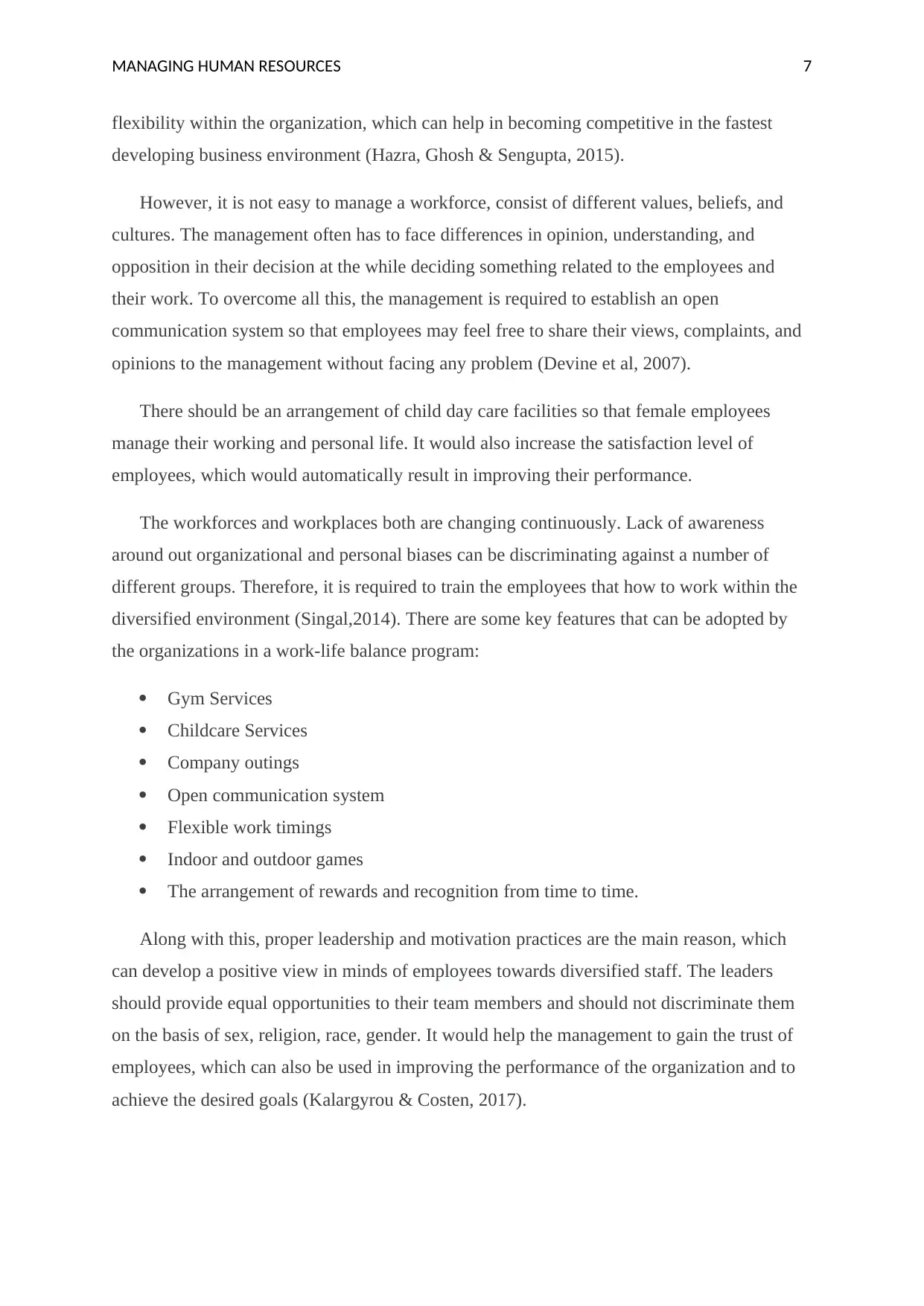
MANAGING HUMAN RESOURCES 7
flexibility within the organization, which can help in becoming competitive in the fastest
developing business environment (Hazra, Ghosh & Sengupta, 2015).
However, it is not easy to manage a workforce, consist of different values, beliefs, and
cultures. The management often has to face differences in opinion, understanding, and
opposition in their decision at the while deciding something related to the employees and
their work. To overcome all this, the management is required to establish an open
communication system so that employees may feel free to share their views, complaints, and
opinions to the management without facing any problem (Devine et al, 2007).
There should be an arrangement of child day care facilities so that female employees
manage their working and personal life. It would also increase the satisfaction level of
employees, which would automatically result in improving their performance.
The workforces and workplaces both are changing continuously. Lack of awareness
around out organizational and personal biases can be discriminating against a number of
different groups. Therefore, it is required to train the employees that how to work within the
diversified environment (Singal,2014). There are some key features that can be adopted by
the organizations in a work-life balance program:
Gym Services
Childcare Services
Company outings
Open communication system
Flexible work timings
Indoor and outdoor games
The arrangement of rewards and recognition from time to time.
Along with this, proper leadership and motivation practices are the main reason, which
can develop a positive view in minds of employees towards diversified staff. The leaders
should provide equal opportunities to their team members and should not discriminate them
on the basis of sex, religion, race, gender. It would help the management to gain the trust of
employees, which can also be used in improving the performance of the organization and to
achieve the desired goals (Kalargyrou & Costen, 2017).
flexibility within the organization, which can help in becoming competitive in the fastest
developing business environment (Hazra, Ghosh & Sengupta, 2015).
However, it is not easy to manage a workforce, consist of different values, beliefs, and
cultures. The management often has to face differences in opinion, understanding, and
opposition in their decision at the while deciding something related to the employees and
their work. To overcome all this, the management is required to establish an open
communication system so that employees may feel free to share their views, complaints, and
opinions to the management without facing any problem (Devine et al, 2007).
There should be an arrangement of child day care facilities so that female employees
manage their working and personal life. It would also increase the satisfaction level of
employees, which would automatically result in improving their performance.
The workforces and workplaces both are changing continuously. Lack of awareness
around out organizational and personal biases can be discriminating against a number of
different groups. Therefore, it is required to train the employees that how to work within the
diversified environment (Singal,2014). There are some key features that can be adopted by
the organizations in a work-life balance program:
Gym Services
Childcare Services
Company outings
Open communication system
Flexible work timings
Indoor and outdoor games
The arrangement of rewards and recognition from time to time.
Along with this, proper leadership and motivation practices are the main reason, which
can develop a positive view in minds of employees towards diversified staff. The leaders
should provide equal opportunities to their team members and should not discriminate them
on the basis of sex, religion, race, gender. It would help the management to gain the trust of
employees, which can also be used in improving the performance of the organization and to
achieve the desired goals (Kalargyrou & Costen, 2017).
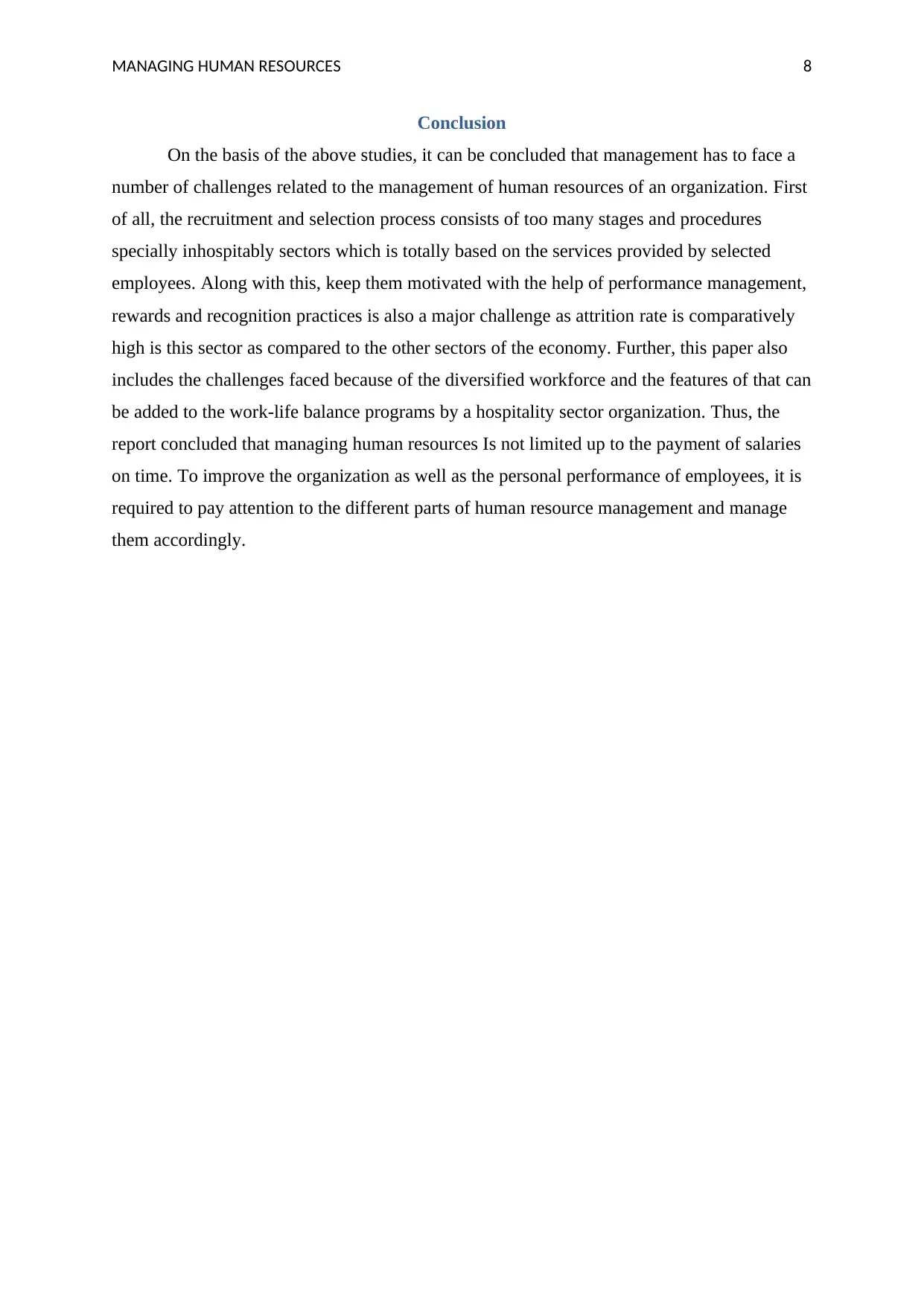
MANAGING HUMAN RESOURCES 8
Conclusion
On the basis of the above studies, it can be concluded that management has to face a
number of challenges related to the management of human resources of an organization. First
of all, the recruitment and selection process consists of too many stages and procedures
specially inhospitably sectors which is totally based on the services provided by selected
employees. Along with this, keep them motivated with the help of performance management,
rewards and recognition practices is also a major challenge as attrition rate is comparatively
high is this sector as compared to the other sectors of the economy. Further, this paper also
includes the challenges faced because of the diversified workforce and the features of that can
be added to the work-life balance programs by a hospitality sector organization. Thus, the
report concluded that managing human resources Is not limited up to the payment of salaries
on time. To improve the organization as well as the personal performance of employees, it is
required to pay attention to the different parts of human resource management and manage
them accordingly.
Conclusion
On the basis of the above studies, it can be concluded that management has to face a
number of challenges related to the management of human resources of an organization. First
of all, the recruitment and selection process consists of too many stages and procedures
specially inhospitably sectors which is totally based on the services provided by selected
employees. Along with this, keep them motivated with the help of performance management,
rewards and recognition practices is also a major challenge as attrition rate is comparatively
high is this sector as compared to the other sectors of the economy. Further, this paper also
includes the challenges faced because of the diversified workforce and the features of that can
be added to the work-life balance programs by a hospitality sector organization. Thus, the
report concluded that managing human resources Is not limited up to the payment of salaries
on time. To improve the organization as well as the personal performance of employees, it is
required to pay attention to the different parts of human resource management and manage
them accordingly.
⊘ This is a preview!⊘
Do you want full access?
Subscribe today to unlock all pages.

Trusted by 1+ million students worldwide
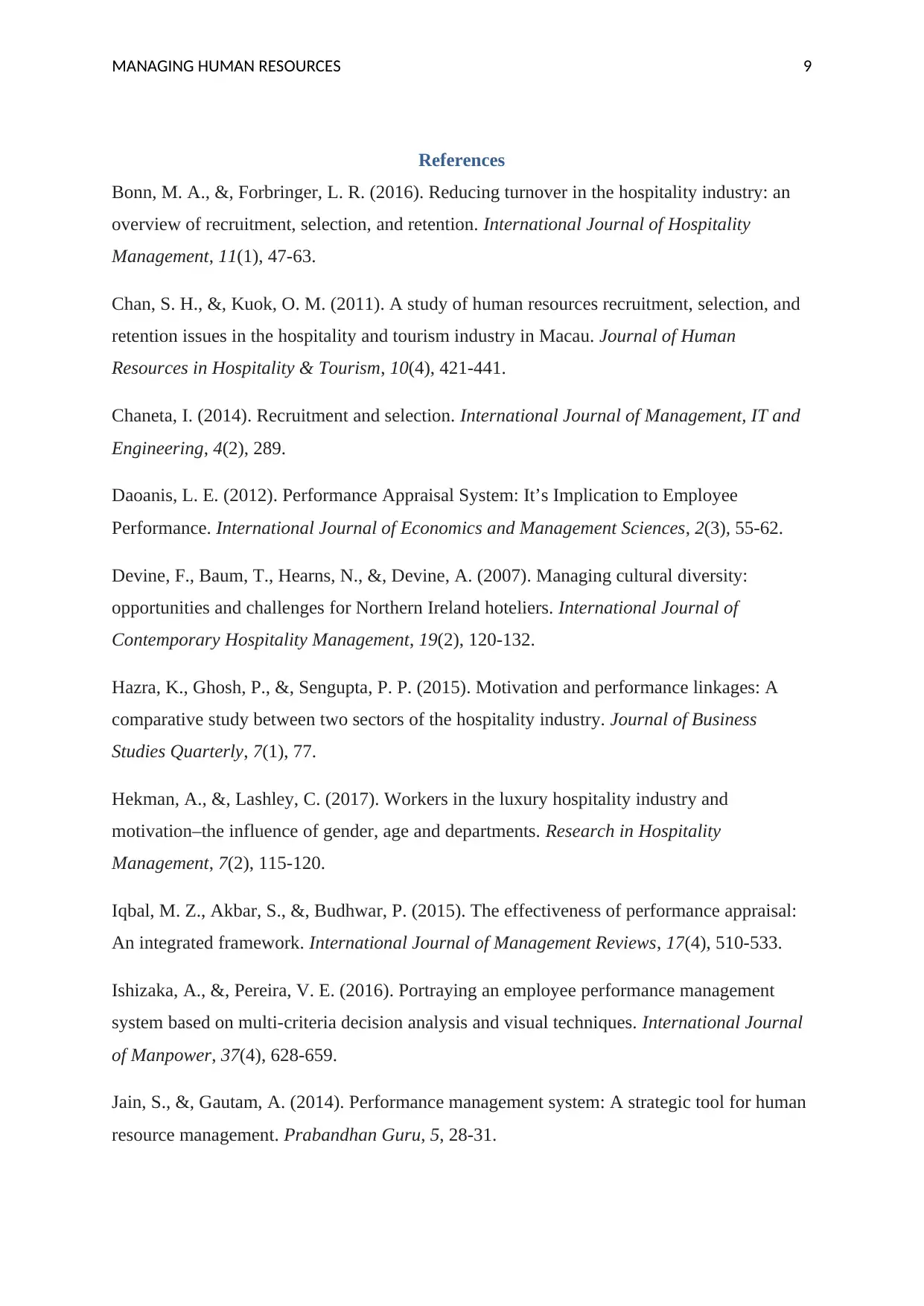
MANAGING HUMAN RESOURCES 9
References
Bonn, M. A., &, Forbringer, L. R. (2016). Reducing turnover in the hospitality industry: an
overview of recruitment, selection, and retention. International Journal of Hospitality
Management, 11(1), 47-63.
Chan, S. H., &, Kuok, O. M. (2011). A study of human resources recruitment, selection, and
retention issues in the hospitality and tourism industry in Macau. Journal of Human
Resources in Hospitality & Tourism, 10(4), 421-441.
Chaneta, I. (2014). Recruitment and selection. International Journal of Management, IT and
Engineering, 4(2), 289.
Daoanis, L. E. (2012). Performance Appraisal System: It’s Implication to Employee
Performance. International Journal of Economics and Management Sciences, 2(3), 55-62.
Devine, F., Baum, T., Hearns, N., &, Devine, A. (2007). Managing cultural diversity:
opportunities and challenges for Northern Ireland hoteliers. International Journal of
Contemporary Hospitality Management, 19(2), 120-132.
Hazra, K., Ghosh, P., &, Sengupta, P. P. (2015). Motivation and performance linkages: A
comparative study between two sectors of the hospitality industry. Journal of Business
Studies Quarterly, 7(1), 77.
Hekman, A., &, Lashley, C. (2017). Workers in the luxury hospitality industry and
motivation–the influence of gender, age and departments. Research in Hospitality
Management, 7(2), 115-120.
Iqbal, M. Z., Akbar, S., &, Budhwar, P. (2015). The effectiveness of performance appraisal:
An integrated framework. International Journal of Management Reviews, 17(4), 510-533.
Ishizaka, A., &, Pereira, V. E. (2016). Portraying an employee performance management
system based on multi-criteria decision analysis and visual techniques. International Journal
of Manpower, 37(4), 628-659.
Jain, S., &, Gautam, A. (2014). Performance management system: A strategic tool for human
resource management. Prabandhan Guru, 5, 28-31.
References
Bonn, M. A., &, Forbringer, L. R. (2016). Reducing turnover in the hospitality industry: an
overview of recruitment, selection, and retention. International Journal of Hospitality
Management, 11(1), 47-63.
Chan, S. H., &, Kuok, O. M. (2011). A study of human resources recruitment, selection, and
retention issues in the hospitality and tourism industry in Macau. Journal of Human
Resources in Hospitality & Tourism, 10(4), 421-441.
Chaneta, I. (2014). Recruitment and selection. International Journal of Management, IT and
Engineering, 4(2), 289.
Daoanis, L. E. (2012). Performance Appraisal System: It’s Implication to Employee
Performance. International Journal of Economics and Management Sciences, 2(3), 55-62.
Devine, F., Baum, T., Hearns, N., &, Devine, A. (2007). Managing cultural diversity:
opportunities and challenges for Northern Ireland hoteliers. International Journal of
Contemporary Hospitality Management, 19(2), 120-132.
Hazra, K., Ghosh, P., &, Sengupta, P. P. (2015). Motivation and performance linkages: A
comparative study between two sectors of the hospitality industry. Journal of Business
Studies Quarterly, 7(1), 77.
Hekman, A., &, Lashley, C. (2017). Workers in the luxury hospitality industry and
motivation–the influence of gender, age and departments. Research in Hospitality
Management, 7(2), 115-120.
Iqbal, M. Z., Akbar, S., &, Budhwar, P. (2015). The effectiveness of performance appraisal:
An integrated framework. International Journal of Management Reviews, 17(4), 510-533.
Ishizaka, A., &, Pereira, V. E. (2016). Portraying an employee performance management
system based on multi-criteria decision analysis and visual techniques. International Journal
of Manpower, 37(4), 628-659.
Jain, S., &, Gautam, A. (2014). Performance management system: A strategic tool for human
resource management. Prabandhan Guru, 5, 28-31.
Paraphrase This Document
Need a fresh take? Get an instant paraphrase of this document with our AI Paraphraser
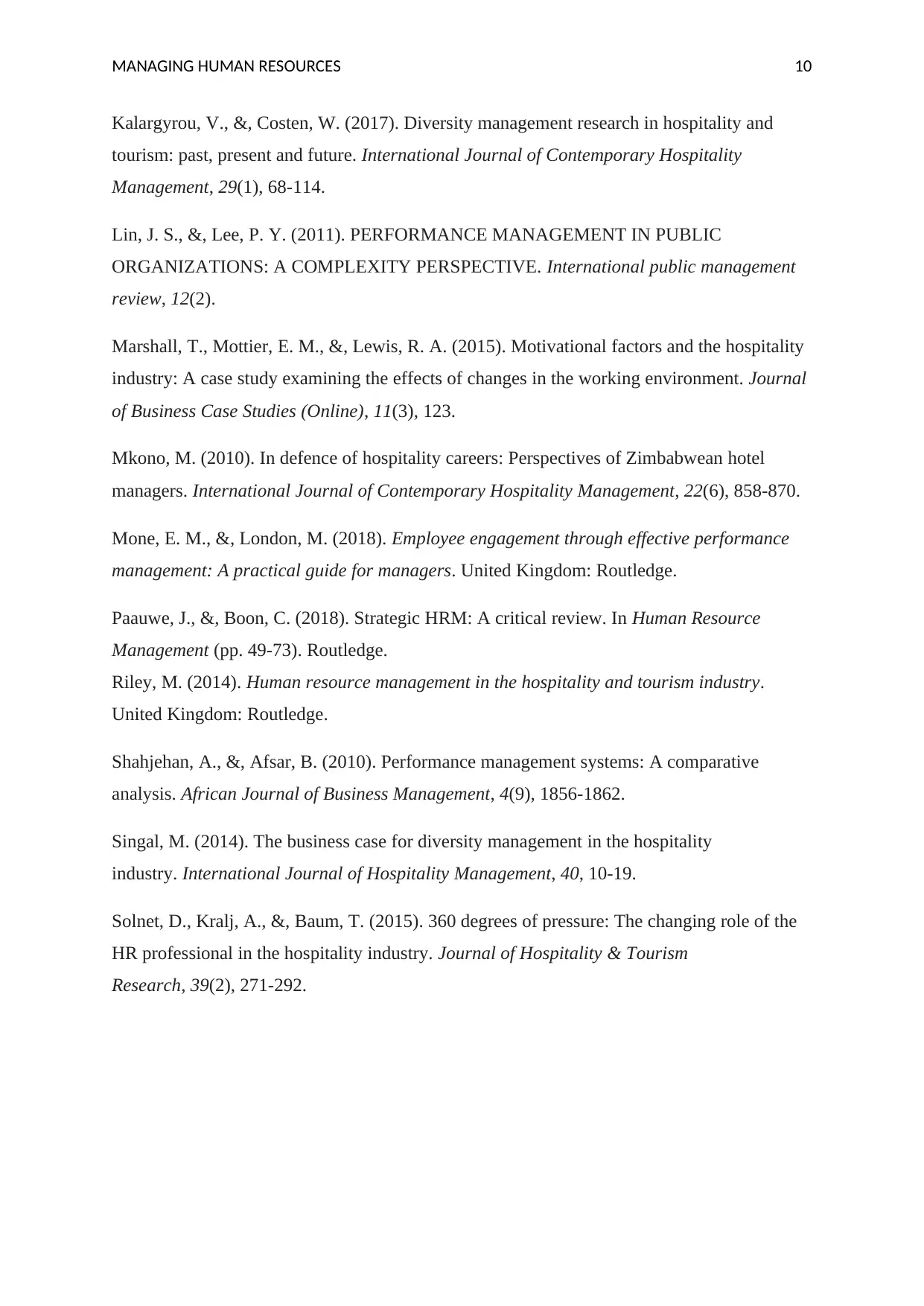
MANAGING HUMAN RESOURCES 10
Kalargyrou, V., &, Costen, W. (2017). Diversity management research in hospitality and
tourism: past, present and future. International Journal of Contemporary Hospitality
Management, 29(1), 68-114.
Lin, J. S., &, Lee, P. Y. (2011). PERFORMANCE MANAGEMENT IN PUBLIC
ORGANIZATIONS: A COMPLEXITY PERSPECTIVE. International public management
review, 12(2).
Marshall, T., Mottier, E. M., &, Lewis, R. A. (2015). Motivational factors and the hospitality
industry: A case study examining the effects of changes in the working environment. Journal
of Business Case Studies (Online), 11(3), 123.
Mkono, M. (2010). In defence of hospitality careers: Perspectives of Zimbabwean hotel
managers. International Journal of Contemporary Hospitality Management, 22(6), 858-870.
Mone, E. M., &, London, M. (2018). Employee engagement through effective performance
management: A practical guide for managers. United Kingdom: Routledge.
Paauwe, J., &, Boon, C. (2018). Strategic HRM: A critical review. In Human Resource
Management (pp. 49-73). Routledge.
Riley, M. (2014). Human resource management in the hospitality and tourism industry.
United Kingdom: Routledge.
Shahjehan, A., &, Afsar, B. (2010). Performance management systems: A comparative
analysis. African Journal of Business Management, 4(9), 1856-1862.
Singal, M. (2014). The business case for diversity management in the hospitality
industry. International Journal of Hospitality Management, 40, 10-19.
Solnet, D., Kralj, A., &, Baum, T. (2015). 360 degrees of pressure: The changing role of the
HR professional in the hospitality industry. Journal of Hospitality & Tourism
Research, 39(2), 271-292.
Kalargyrou, V., &, Costen, W. (2017). Diversity management research in hospitality and
tourism: past, present and future. International Journal of Contemporary Hospitality
Management, 29(1), 68-114.
Lin, J. S., &, Lee, P. Y. (2011). PERFORMANCE MANAGEMENT IN PUBLIC
ORGANIZATIONS: A COMPLEXITY PERSPECTIVE. International public management
review, 12(2).
Marshall, T., Mottier, E. M., &, Lewis, R. A. (2015). Motivational factors and the hospitality
industry: A case study examining the effects of changes in the working environment. Journal
of Business Case Studies (Online), 11(3), 123.
Mkono, M. (2010). In defence of hospitality careers: Perspectives of Zimbabwean hotel
managers. International Journal of Contemporary Hospitality Management, 22(6), 858-870.
Mone, E. M., &, London, M. (2018). Employee engagement through effective performance
management: A practical guide for managers. United Kingdom: Routledge.
Paauwe, J., &, Boon, C. (2018). Strategic HRM: A critical review. In Human Resource
Management (pp. 49-73). Routledge.
Riley, M. (2014). Human resource management in the hospitality and tourism industry.
United Kingdom: Routledge.
Shahjehan, A., &, Afsar, B. (2010). Performance management systems: A comparative
analysis. African Journal of Business Management, 4(9), 1856-1862.
Singal, M. (2014). The business case for diversity management in the hospitality
industry. International Journal of Hospitality Management, 40, 10-19.
Solnet, D., Kralj, A., &, Baum, T. (2015). 360 degrees of pressure: The changing role of the
HR professional in the hospitality industry. Journal of Hospitality & Tourism
Research, 39(2), 271-292.
1 out of 11
Related Documents
Your All-in-One AI-Powered Toolkit for Academic Success.
+13062052269
info@desklib.com
Available 24*7 on WhatsApp / Email
![[object Object]](/_next/static/media/star-bottom.7253800d.svg)
Unlock your academic potential
Copyright © 2020–2025 A2Z Services. All Rights Reserved. Developed and managed by ZUCOL.




